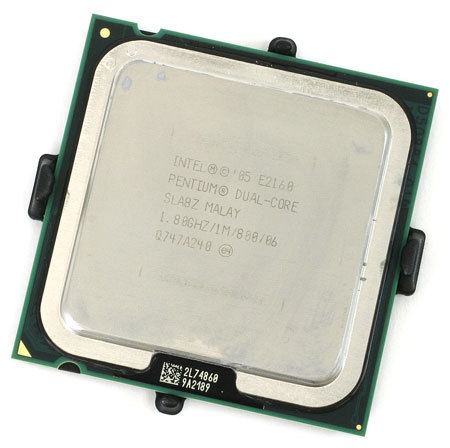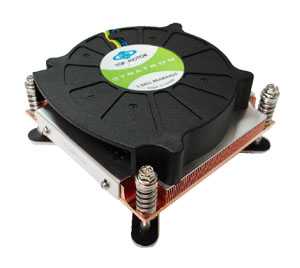How To: Building Your Own Render Farm
Hardware Component Selection For Each Node
Processor selection is dependent on two things: how much you're able to spend and resulting value. Even more so than normal desktop systems, render nodes are sensitive to these factors. There is a certain point on the processor performance curve where the next increment in compute speed results in a pricing jump that is out of order with the increase in performance. However, with today's higher bus speeds, too little cache on a processor can leave it starved for data. So, for discussion's sake, we'll shy away from Celerons as the bottom-end processor and instead use low-end dual-core Pentiums.
Using a lower-cost dual-core Pentium can give you a very inexpensive render node with a minimum sacrifice of performance. The Cinema 4D Release 10 chart shows the performance curve. While dual-core Pentiums and Celerons are not in these charts, you can see that there are spots in the Intel processor lineup where there is a significant jump in price for very little increase in performance. Find the price that you are willing to pay and then look at the best performance for your price range.
A dual-core Pentium, a slightly faster Core 2 Duo, or even a low-end Core 2 Quad are all good choices for building a node. It's really all about how much you want to spend here, because this is the single most expensive component required for each node. At the other end of the spectrum, building a Core i7-based system is going to increase the price of the entire node out of proportion to its increased performance. However, if you want to moderately future-proof your nodes and increase the likelihood of being able to get a processor upgrade for it later, you may want to consider that route.
A low-profile 1U heat sink is required for a corresponding case, most of which are made to specifically draw air from the front to the back of the machine. The limits in choices in processor cooling also limit (or even restrict) the possibility of overclocking the nodes. The Dynatron P199 pictured above is fairly typical and can handle quad-core processors.
Storage
Because the local drive will just be used for your operating system and applications, pick a small drive. An 80 GB drive is the smallest SATA drive commonly available, so that's what we recommend. However, if you use a drive with a digital audio workstation (that setup is discussed below) then a 320 GB, or maybe even a 500 GB drive, is a better choice.
Assuming you are building multiple nodes, you are only going to buy a single DVD drive (even if you are building 10 systems). You'll build your first machine, install the operating system plus software with updates, and then use Sysprep to blank the registration number. Next, use Norton Ghost 14 or similar drive-imaging software to clone the disk for subsequent machines. Each new system will require a fresh network name, and you will have to enter the Windows license key for each of the cloned machines. This keeps you from having to install the operating system, the applications, and the updates on each of the machines separately. If you build additional nodes using the same hardware in the future, it's also a good idea to clone one extra drive and keep the original as a master drive.
Get Tom's Hardware's best news and in-depth reviews, straight to your inbox.
The operating system for your nodes should be similar (but not necessarily identical) to your operating system. Since 64-bit Windows XP is still available through OEM channels, there is no need for you to even consider putting Vista on your nodes, wasting memory and processing power. If your 3D application's network renderer (and all of the plugins that your network renderer needs, including third-party plugins) are supported under Linux, you may want to consider running Linux on the nodes instead, which makes the nodes even cheaper. A total of 10 copies of XP (for 10 nodes) may sound like a big expense, but it actually adds $140 per unit, pushing the cost of these machines to about $485 per unit for a dual-core node or $610 per unit for a quad-core configuration.
| Component | Dual-Core | Price | Quad-Core | Price |
|---|---|---|---|---|
| Casing | Supermicro CSE-512L-260 | $94.99 | Supermicro CSE-512L-260 | $94.99 |
| Motherboard | Asus P5B-VM SE | $59.99 | Asus P5B-VM SE | $59.99 |
| Processor | Intel Core 2 Duo E7200 | $91.99 | Intel Core 2 Quad Q8200 | $164.99 |
| Heat Sink | Dynatron P199 | $30.99 | Dynatron P199 | $30.99 |
| Memory | Patriot Viper PVS24G6400LLK – (2 GB x 2) | $51.99 | Two Patriot Viper PVS24G6400LLK – (2 GB x 4) | $103.98 |
| Hard Drive | Seagate Barracuda 7200.10 ST380215A 80 GB | $36.99 | Seagate Barracuda 7200.10 ST380215A 80 GB | $36.99 |
| Operating System | Windows XP Pro 64-bit | $139.99 | Windows XP Pro 64-bit | $139.99 |
| Total (With Shipping) | Row 7 - Cell 1 | $485.11 | Row 7 - Cell 3 | $610.10 |
So here’s what we’re looking at for a per-node price, with both dual- and quad-core processors. Remember, these are prices we found when this article was written, and they should change in the near future.
Current page: Hardware Component Selection For Each Node
Prev Page Rolling Your Own Render Node Next Page Render Node Considerations-
borandi And soon they'll all move to graphics cards rendering. Simple. This article for now: worthless.Reply -
Draven35 People have been saying that for several years now, and Nvidia has killed Gelato. Every time that there has been an effort to move to GPU-based rendering, there has been a change to how things are rendered that has made it ineffective to do so.Reply -
borandi With the advent of OpenCL at the tail end of the year, and given that a server farm is a centre for multiparallel processes, GPGPU rendering should be around the corner. You can't ignore the power of 1.2TFlops per PCI-E slot (if you can render efficiently enough), or 2.4TFlops per kilowatt, as opposed to 10 old Pentium Dual Cores in a rack.Reply -
Draven35 Yes, but it still won't render in real time. You'll still need render time, and that means separate systems. i did not ignore that in the article, and in fact discussed GPU-based rendering and ways to prepare your nodes for that. Just because you may start rendering on a GPU, does not mean it will be in real time. TV rendering is now in high definitiion, (finished in 1080p, usually) and rendering for film is done in at least that resolution, or 2k-4k. If you think you're going to use GPU-based rendering, get boards with an x16 slot, and rsier cards, then put GPUs in the units when you start using it. Considering software development cycles, It will likely be a year before a GPGPU-based renderer made in OpenCL is available from any 3D software vendors for at least a year (i.e. SIGGRAPH 2010). Most 3D animators do not and will not develop their own renderers.Reply -
ytoledano While I never rendered any 3d scenes, I did learn a lot on building a home server rack. I'm working on a project which involves combinatorial optimization and genetic algorithms - both need a lot of processing power and can be easily split to many processing units. I was surprised to see how cheap one quad core node can be.Reply -
Draven35 Great, thanks- its very cool to hear someone cite another use of this type of setup. Hope you found some useful data.Reply -
MonsterCookie Due to my job I work on parallel computers every day.Reply
I got to say: building a cheapo C2D might be OK, but still it is better nowadays to buy cheap C2Q instead, because the price/performance ratio of the machine is considerably better.
However, please DO NOT spend more than 30% of you money on useless M$ products.
Be serious, and keep cheap things cheap, and spend your hard earned money on a better machine or on your wife/kids/bear instead.
Use linux, solaris, whatsoever ...
Better performance, better memory management, higher stability.
IN FACT, most real design/3D applications run under unixoid operating systems. -
ricstorms Actually I think if you look at a value analysis, AMD could actually give a decent value for the money. Get an old Phenom 9600 for $89 and build some ridiculously cheap workstations and nodes. The only thing that would kill you is power consumption, I don't think the 1st gen Phenoms were good at undervolting (of course they weren't good on a whole lot of things). Of course the Q8200 would trounce it, but Intel won't put their Quads south of $150 (not that they really need to).Reply -
eaclou Thanks for doing an article on workstations -- sometimes it feels like all of the articles are only concerned with gaming.Reply
I'm not to the point yet where I really need a render farm, but this information might come in handy in a year or two. (and I severely doubt GPU rendering will make CPU rendering a thing of the past in 2 years)
I look forward to future articles on workstations
-Is there any chance of a comparison between workstation graphics cards and gaming graphics cards? -
cah027 I wish these software companies would get on the ball. There are consumer level software packages that will use multiple cpu cores as well as GPU all at the same time. Then someone could build a 4 socket, 6 GPU box all in one that would do the work equal to several cheap nodes!Reply

